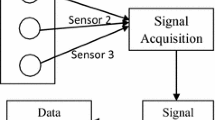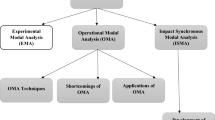Abstract
The dynamic parameters of a machine tool under the operating state are different from those under the static state. It is more accurate to use the dynamic parameters in the operating state to simulate the machining process and predict the machining stability. Operational modal analysis is a powerful tool to estimate the dynamic parameters of the machine tool in the operating condition; however, it has the problem of missing the scaling factor of the mode shape. Hence, the frequency response function (FRF) cannot be identified directly. To address this issue, this paper proposed a new method to obtain the in-process FRF based on the operational modal analysis (OMA) and the experiment modal analysis (EMA). This method employs the natural frequencies and damping ratios from the OMA and the modal constants from the EMA to compose the FRF for the operating condition. The method is verified by simulation of a three-degree-of-freedom mass-spring-damper system and is applied to the identification of the FRF for the work table of a machine tool.
Similar content being viewed by others
References
Kolar P, Sulitka M, Janota M (2011) Simulation of dynamic properties of a spindle and tool system coupled with a machine tool frame. Int J Adv Manuf Technol 54(1):11–20. https://doi.org/10.1007/s00170-010-2917-7
Albertelli P, Cau N, Bianchi G, Monno M (2012) The effects of dynamic interaction between machine tool subsystems on cutting process stability. Int J Adv Manuf Technol 58(9):923–932. https://doi.org/10.1007/s00170-011-3465-5
Law M, Altintas Y, Phani AS (2013) Rapid evaluation and optimization of machine tools with position-dependent stability. Int J Mach Tools Manuf 68:81–90. https://doi.org/10.1016/j.ijmachtools.2013.02.003
Ye BS, Xiao WW, Mao KM, Li B (2017) Hybrid analytic-experimental modeling for machine tool structural dynamics. Int J Adv Manuf Technol 90(5–8):1679–1691. https://doi.org/10.1007/s00170-016-9507-2
Luo B, Pan D, Cai H, Mao XY, Peng FY, Mao KM, Li B (2015) A method to predict position-dependent structural natural frequencies of machine tool. Int J Mach Tools Manuf 92:72–84. https://doi.org/10.1016/j.ijmachtools.2015.02.009
Deng CY, Liu Y, Zhao J, Wei B, Yin GF (2017) Analysis of the machine tool dynamic characteristics in manufacturing space based on the generalized dynamic response model. Int J Adv Manuf Technol:1–14
Zhang J, Zhang HJ, Du C, Zhao WH (2016) Research on the dynamics of ball screw feed system with high acceleration. Int J Mach Tools Manuf 111:9–16. https://doi.org/10.1016/j.ijmachtools.2016.09.001
Wang L, Liu H, Yang L, Zhang J, Zhao WH, BH L (2015) The effect of axis coupling on machine tool dynamics determined by tool deviation. Int J Mach Tools Manuf 88:71–81. https://doi.org/10.1016/j.ijmachtools.2014.09.003
Liu H, He Y, Mao X, Li B, Liu X (2017) Effects of cutting conditions on excitation and dynamic stiffness in milling. Int J Adv Manuf Technol 91(1–4):813–822. https://doi.org/10.1007/s00170-016-9809-4
Zaghbani I, Songmene V (2009) Estimation of machine-tool dynamic parameters during machining operation through operational modal analysis. Int J Mach Tools Manuf 49(12–13):947–957. https://doi.org/10.1016/j.ijmachtools.2009.06.010
Li B, Luo B, Mao XY, Cai H, Peng FY, Liu HQ (2013) A new approach to identifying the dynamic behavior of CNC machine tools with respect to different worktable feed speeds. Int J Mach Tools Manuf 72:73–84. https://doi.org/10.1016/j.ijmachtools.2013.06.004
Li B, Cai H, Mao XY, Huang JB, Luo B (2013) Estimation of CNC machine–tool dynamic parameters based on random cutting excitation through operational modal analysis. Int J Mach Tools Manuf 71:26–40. https://doi.org/10.1016/j.ijmachtools.2013.04.001
Brincker R, Kirkegaard PH (2009) Special issue on operational modal analysis. Mech Syst Signal Pr 24:1209–1212
Parloo E, Verboven P, Guillaume P, Van Overmeire M (2002) Sensitivity-based operational mode shape normalisation. Mech Syst Signal Pr 16(5):757–767. https://doi.org/10.1006/mssp.2002.1498
Coppotelli G (2009) On the estimate of the FRFs from operational data. Mech Syst Signal Pr 23(2):288–299. https://doi.org/10.1016/j.ymssp.2008.05.004
Aenlle ML, Brincker R (2013) Modal scaling in operational modal analysis using a finite element model. Int J Mech Sci 76(6):86–101. https://doi.org/10.1016/j.ijmecsci.2013.09.003
Reynders E, De Roeck G (2008) Reference-based combined deterministic–stochastic subspace identification for experimental and operational modal analysis. Mech Syst Signal Pr 22(3):617–637. https://doi.org/10.1016/j.ymssp.2007.09.004
Cara J (2016) Computing the modal mass from the state space model in combined experimental–operational modal analysis. J Sound Vib 370:94–110. https://doi.org/10.1016/j.jsv.2016.01.043
Mao X, Luo B, Li B, Cai H, Liu HQ, Peng FY (2014) An approach for measuring the FRF of machine tool structure without knowing any input force. Int J Mach Tools Manuf 86:62–67. https://doi.org/10.1016/j.ijmachtools.2014.07.004
Cai H, Mao X, Li B, Luo B (2015) Estimation of FRFs of machine tools in output-only modal analysis. Int J Adv Manuf Technol 77(1–4):117–130. https://doi.org/10.1007/s00170-014-6439-6
Powałka B, Jemielniak K (2015) Stability analysis in milling of flexible parts based on operational modal analysis. CIRP J Manuf Sci Technol 9:125–135. https://doi.org/10.1016/j.cirpj.2014.11.003
Özşahin O, Budak E, Özgüven HN (2015) In-process tool point FRF identification under operational conditions using inverse stability solution. Int J Mach Tools Manuf 89:64–73. https://doi.org/10.1016/j.ijmachtools.2014.09.014
Funding
This work was funded by the Natural Science Foundation of China (NSFC) under Grant No. 51375193, the National Basic Research Program of China under Grant No. 2013CB035805, and the Key Projects in the National Science & Technology Pillar Program of China under Grant No. 2014ZX04014101.
Author information
Authors and Affiliations
Corresponding author
Rights and permissions
About this article
Cite this article
Peng, Y., Li, B., Mao, X. et al. A method to obtain the in-process FRF of a machine tool based on operational modal analysis and experiment modal analysis. Int J Adv Manuf Technol 95, 3599–3607 (2018). https://doi.org/10.1007/s00170-017-1405-8
Received:
Accepted:
Published:
Issue Date:
DOI: https://doi.org/10.1007/s00170-017-1405-8




